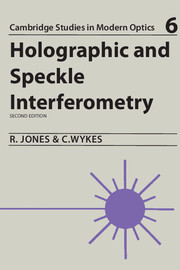Book contents
- Frontmatter
- Contents
- Preface to the first edition
- Preface to the second edition
- Acknowledgements
- 1 Basic optical principles
- 2 Holographic interferometry
- 3 Speckle pattern interferometry
- 4 Electronic Speckle Pattern Correlation Interferometry
- 5 Holographic and speckle pattern interferometry techniques for shape measurements
- 6 Experimental design and technique
- 7 Applications
- Appendices
- References
- Index
6 - Experimental design and technique
Published online by Cambridge University Press: 05 August 2012
- Frontmatter
- Contents
- Preface to the first edition
- Preface to the second edition
- Acknowledgements
- 1 Basic optical principles
- 2 Holographic interferometry
- 3 Speckle pattern interferometry
- 4 Electronic Speckle Pattern Correlation Interferometry
- 5 Holographic and speckle pattern interferometry techniques for shape measurements
- 6 Experimental design and technique
- 7 Applications
- Appendices
- References
- Index
Summary
Introduction
The successful use of the techniques described in the previous chapters requires that some insight into experimental design and technique be gained. A good way of doing this is to actually carry out the required experiment together with the associated measurements. This approach is quite sound as long as it is borne in mind that a considerable amount of time and money can often be saved if the experiment is based on a brief theoretical study of the practical factors involved. The contents of this chapter are intended to provide the basis for such an approach. Readers may also find that the practical details discussed enhance their understanding of the theoretical principles already expounded.
Some factors affecting the selection of experimental technique
The techniques discussed in this book enable the following types of measurement to be made:
(i) Static and quasi-static surface displacements, using holographic interferometry (Chapter 2), or speckle pattern interferometry (Chapters 3 and 4).
(ii) Dynamic surface displacements using modified versions of the same general method as (i).
(iii) Surface shape based on dual wavelength Electronic Speckle Pattern Interferometry, dual wavelength holographic interferometry and fringe projection methods (Chapter 5).
Sensitivities for the above methods have been defined at various points in the text. The sensitivities of the various displacement techniques are summarized in Table 6.1 and the accompanying notes.
This information can be used as a guide when a technique is to be selected for the solution of a particular problem.
- Type
- Chapter
- Information
- Holographic and Speckle Interferometry , pp. 239 - 273Publisher: Cambridge University PressPrint publication year: 1989

